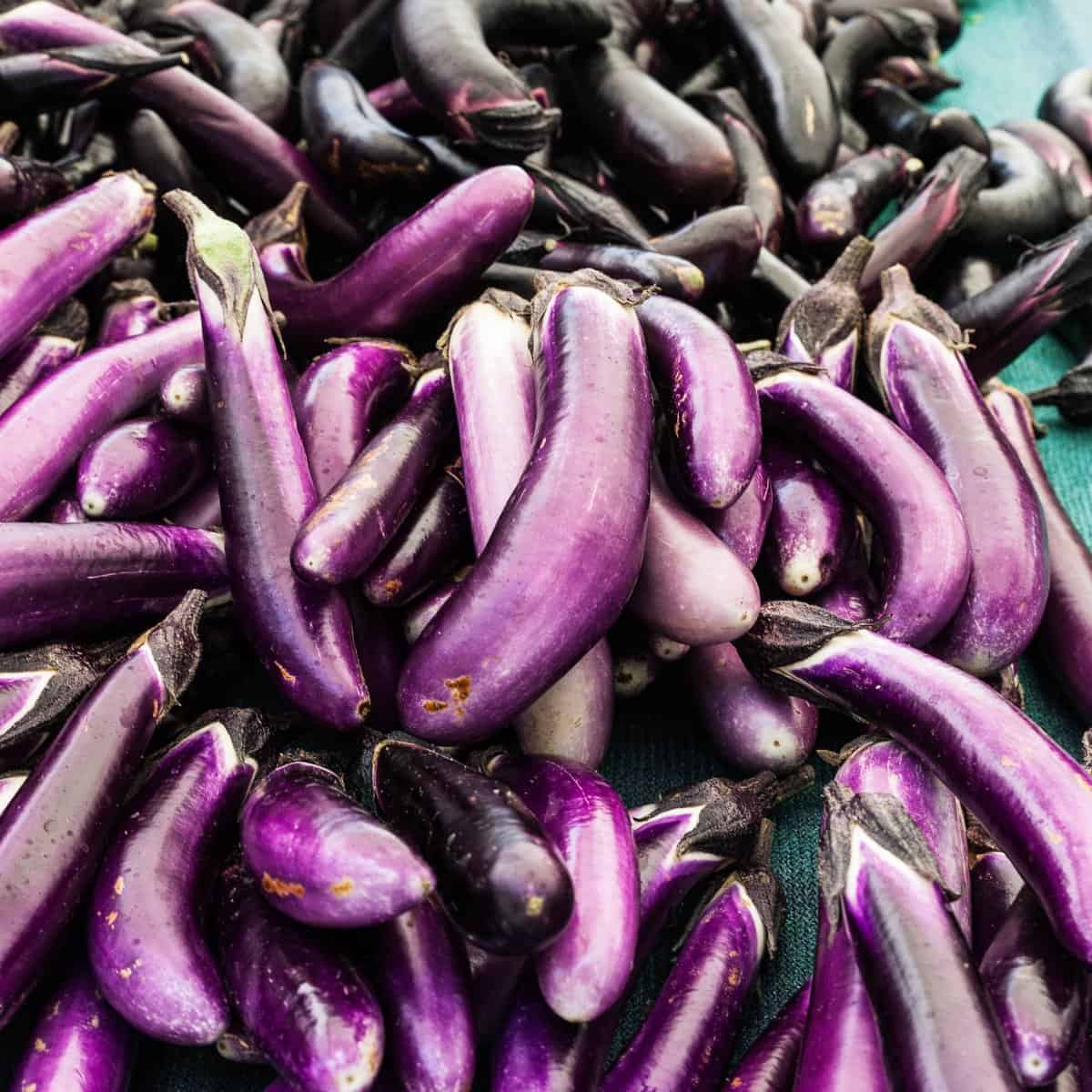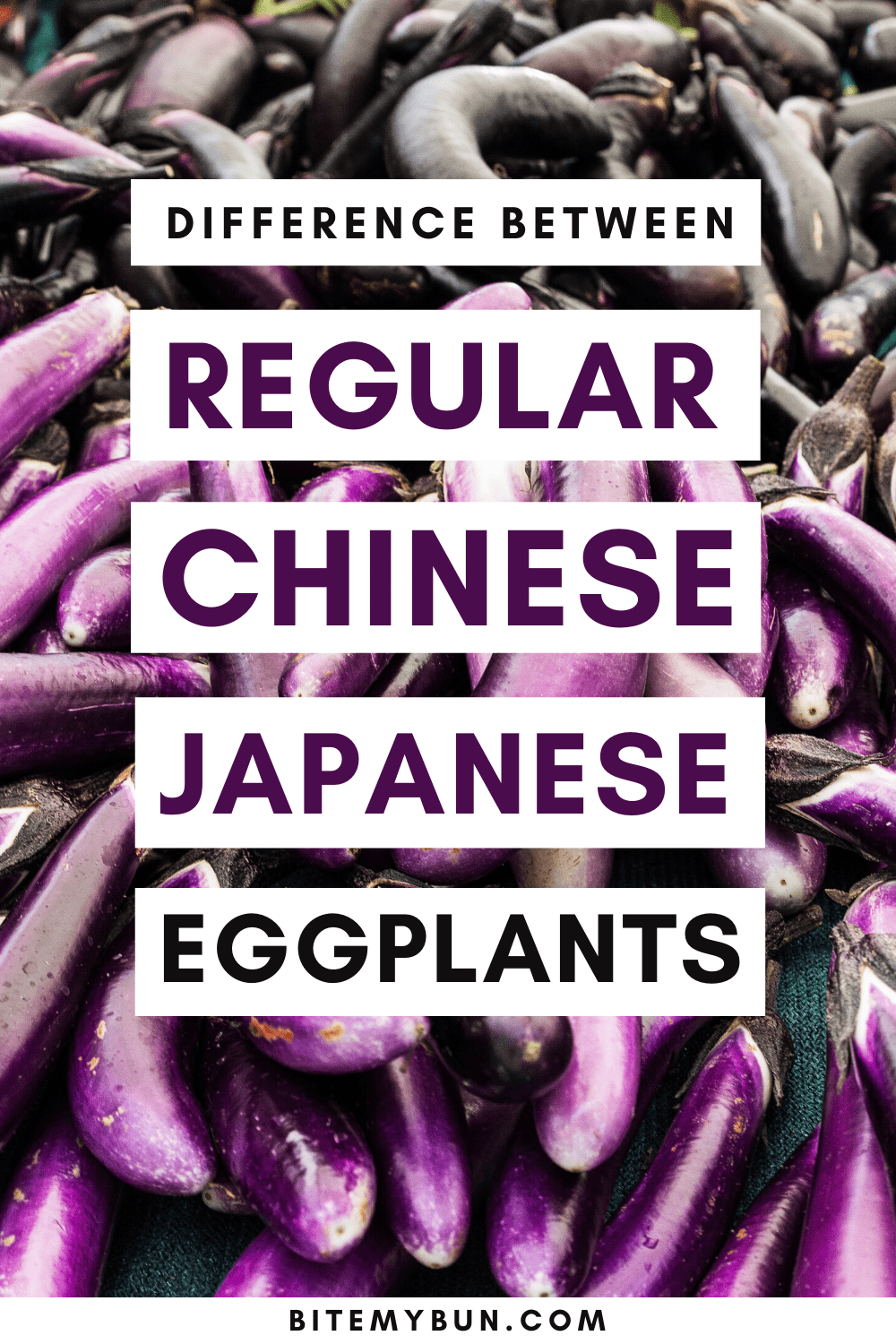Eggplant: How to Pick, Prep, and Cook the Perfect Dish
The humble eggplant is a vegetable that can be used in many dishes. It’s versatile and can be used as a substitute for meat in vegetarian dishes.
The eggplant is a versatile vegetable that can be used in many dishes. It’s perfect for replacing meat in vegetarian dishes. You can use it in Italian, Asian, and Mediterranean dishes.
In this guide, I’ll show you how to cook with eggplant and unlock its full potential. I’ll also share some of my favorite recipes.


Check out our new cookbook
Bitemybun's family recipes with complete meal planner and recipe guide.
Try it out for free with Kindle Unlimited:
Read for freeIn this post we'll cover:
- 1 Unlocking the Mystery of Eggplant
- 2 Mastering the Art of Cutting and Prepping Eggplant
- 3 Don’t Forget the Salt: The Key to Perfectly Cooked Eggplant
- 4 How to Cook Eggplant: Tips and Tricks
- 5 Choosing the Perfect Eggplant for Your Cooking Needs
- 6 Keeping Eggplants Fresh: Proper Storage Techniques
- 7 Why Eggplant is a Healthy Addition to Your Recipes
- 8 Regular eggplant
- 9 Chinese eggplant
- 10 Japanese eggplant
- 11 Conclusion
Unlocking the Mystery of Eggplant
Eggplant, also known as aubergine, is a type of vegetable that is commonly used in cooking. It is a member of the nightshade family, which also includes tomatoes, potatoes, and peppers. Eggplant comes in different types, shapes, and sizes, depending on where it is grown. The most common type is the large, oval-shaped eggplant with a dark purple skin, but there are also smaller varieties that come in different colors such as white, green, and even black.
Why Eggplant is Excellent for Cooking
Eggplant is an excellent ingredient to use in cooking because it is versatile and can be prepared in many different ways. It is also a great substitute for meat in vegetarian dishes. Here are some reasons why eggplant is an excellent choice for your next recipe:
- Eggplant contains approximately 92% water, making it a low-calorie vegetable that is ideal for those who are watching their weight.
- Eggplant is rich in soluble fiber, which helps to lower cholesterol levels and improve digestion.
- Eggplant is a good source of vitamins and minerals such as vitamin C, vitamin K, vitamin B6, and potassium.
- Eggplant is a good source of antioxidants, which help to protect the body against damage from free radicals.
How to Choose and Store Eggplant
When shopping for eggplant, look for one that is firm and heavy for its size. The skin should be smooth and shiny, without any blemishes or soft spots. To store eggplant, carefully wrap it in a paper towel and place it in a plastic bag. Keep it in the refrigerator for up to five days.
How to Prepare Eggplant for Cooking
Before cooking with eggplant, it is important to prepare it properly. Here are some key steps to follow:
- Cut the eggplant into slices or strips, depending on the recipe.
- Sprinkle salt on the eggplant and let it sit for 30 minutes to remove any bitterness.
- Rinse the eggplant and pat it dry with a paper towel.
How to Incorporate Eggplant into Your Dishes
Eggplant can be used in a variety of dishes, from Italian-style eggplant parmesan to Asian-inspired stir-fries. Here are some ideas to get you started:
- Make a vegetarian eggplant lasagna by layering grilled eggplant with tomato sauce and cheese.
- Add grilled eggplant to a sandwich or wrap for a healthy and filling lunch.
- Make a smoky eggplant dip by blending grilled eggplant with tahini, lemon juice, and garlic.
- Use eggplant as a substitute for meat in a stir-fry or curry.
Mastering the Art of Cutting and Prepping Eggplant
Before you start slicing and dicing, it’s important to choose the right eggplant for your recipe. Here are some tips to keep in mind while shopping:
- Look for eggplants that are firm, shiny, and free of blemishes.
- Choose eggplants that feel heavy for their size, as this indicates they contain more flesh and less air.
- Save a shopping list of certain varieties that you like, such as Japanese or Chinese eggplants, which are ideal for certain recipes.
Sharpening Your Knife
A sharp knife is essential for cutting eggplant properly. Follow these steps to sharpen your knife before you start:
- Hold the knife steady and at a slight angle away from you.
- Start at the base of the blade and draw the knife towards you, going from the base to the tip.
- Repeat this process a couple of times on each side of the blade until it feels sharp.
Cutting and Slicing Eggplant
Now that you have a sharp knife and the right eggplant, it’s time to start cutting and slicing. Here are some methods to try:
- Start by removing the stem and calyx from the top of the eggplant.
- If you want round slices, cut the eggplant horizontally into circles of your desired thickness.
- If you want chunks, cut the eggplant vertically into strips and then into pieces of your desired size.
- If your recipe requires eggplant to be grilled or roasted, slice it vertically into long, thin strips.
- For Japanese-style dishes, cut the eggplant into thin, even pieces.
- Always cut eggplant carefully, as it contains a lot of fiber and can be tough to slice through.
Don’t Forget the Salt: The Key to Perfectly Cooked Eggplant
Adding salt to eggplant is a widely known secret in the kitchen. It’s a simple step that can make a huge difference in the taste and texture of your dish. Here’s why:
- Eggplant contains a lot of water, which can make it soggy and unpleasant when cooked.
- Salt helps to draw out the excess water from the eggplant, making it firmer and less watery.
- Salt also helps to remove any bitterness from the eggplant, which can be especially important if you’re using larger or older eggplants.
Other Methods for Adding Salt to Eggplant
While the above method is the most widely known and used, there are a few other ways to add salt to eggplant:
- Some people prefer to salt the eggplant before slicing it, which can help to draw out even more water. Simply cut the eggplant into the desired size and shape, sprinkle with salt, and let sit for 30 minutes to an hour before rinsing and drying.
- Another method is to add salt to a bowl of water and soak the eggplant slices for 30 minutes to an hour. This can be especially helpful if you’re working with heavier or thicker eggplant slices.
How to Cook Eggplant: Tips and Tricks
Proper preparation is key to cooking eggplant that is both tasty and healthy. Here are some tips:
- Slice the eggplant: Cut the eggplant into even slices or cubes to ensure even cooking. Aim for a thickness of 1/2 inch.
- Salt the eggplant: Salting the eggplant before cooking can help remove any bitterness and excess moisture. Simply sprinkle salt over the sliced eggplant and let it sit in a bowl for 30 minutes. Rinse and pat dry before cooking.
- Dry the eggplant: After salting, gently pat the eggplant slices dry with a paper towel. This will help increase the crispiness of the final dish.
Building Flavor
Eggplant is a versatile vegetable that can be used in a variety of dishes. Here are some tips for building flavor:
- Add spices: Eggplant pairs well with spices like cumin, coriander, and paprika. Experiment with different spice blends to find your favorite.
- Use fresh ingredients: Fresh herbs like basil and parsley can add a pop of flavor to any eggplant dish.
- Substitute eggplant: If you’re not a fan of eggplant, try substituting it with other vegetables like zucchini or bell peppers.
Storing Eggplant
Properly storing eggplant can help extend its shelf life and maintain its quality. Here are some tips:
- Keep it cool: Eggplant should be stored in a cool, dry place like the refrigerator. It can be stored for up to a week.
- Don’t wash until ready to use: Washing eggplant can cause it to spoil faster. Wait until you’re ready to cook before washing.
- Check for freshness: When choosing eggplant, look for ones that are firm and have a smooth, shiny skin. Avoid eggplants with brown spots or soft spots.
By following these tips and tricks, you’ll be able to cook eggplant like a pro and create delicious dishes that everyone will love.
Choosing the Perfect Eggplant for Your Cooking Needs
Step 1: Check the Appearance
When picking out an eggplant, the first thing you want to do is check its appearance. Look for an eggplant that is dark and shiny, with a smooth and firm skin. Avoid eggplants that have any bruises, cuts, or black spots, as these can indicate that the eggplant is overripe or has been damaged.
Step 2: Feel the Eggplant
The next step is to feel the eggplant. Gently press your fingers against the skin of the eggplant to check for firmness. A good eggplant should feel heavy and firm, with no soft spots or wrinkles. If the eggplant feels too light or spongy, it may be overripe or not of good quality.
Step 4: Choose Your Preferred Method of Cooking
Different methods of cooking require different types of eggplants. If you’re looking to grill or roast the eggplant, choose a larger eggplant as this will hold up better on the grill or in the oven. If you’re looking to make a quick stir-fry or add the eggplant to a dish, a smaller eggplant will work fine.
Step 5: Increase Your Chances of Picking a Good Eggplant
If you’re still unsure about how to pick a good eggplant, try these additional tips:
- Look for an eggplant with a wide and even shape, as this will make it easier to slice and prepare.
- Leave the stem on the eggplant until you’re ready to use it, as this will help to keep the eggplant fresh.
- Store the eggplant in a cool, dry place or in the refrigerator wrapped in a paper towel or wire basket to help preserve its natural freshness.
- When slicing the eggplant, use a sharp knife and slice it evenly to ensure that it cooks evenly and presents well in your dishes.
By following these steps and tips, you’ll be able to pick out the perfect eggplant for your cooking needs and build great vegetarian dishes with this versatile vegetable.
Keeping Eggplants Fresh: Proper Storage Techniques
Storing eggplants properly is crucial to prevent them from spoiling and to keep them fresh for longer. Eggplants are sensitive produce and can easily get damaged if not stored correctly. Proper storage will allow you to enjoy the excellent taste of eggplants for weeks after purchase.
Best Types of Eggplants to Store
Not all eggplants are created equal when it comes to storage. Some eggplants are more sensitive than others and require extra care. Here are the best types of eggplants to store:
- Italian eggplants
- Japanese eggplants
- Globe eggplants
How to Store Eggplants at Room Temperature
If you plan to eat your eggplants within a day or two, storing them at room temperature is an excellent option. Here’s how to do it:
- Place the eggplants in a loosely sealed plastic bag or wrap them in paper.
- Store them in a cool, dry place away from direct light and heat.
- Do not cut the eggplants before storing them, as this can cause bruising and spoilage.
How to Store Eggplants in the Fridge
If you want to store your eggplants for longer, the fridge is the best option. Here’s how to do it:
- Wrap the eggplants in paper or place them in a perforated reusable container.
- Store them in the crisper section of your fridge.
- Do not wash the eggplants before storing them, as moisture can cause spoiling.
- If you cut the eggplants, squeeze some lemon juice on the flesh to prevent browning caused by enzymatic reactions.
How to Freeze Eggplants
If you have too many eggplants to eat before they spoil, freezing them is an excellent option. Here’s how to do it:
- Cut the eggplants into slices or cubes.
- Blanch the eggplants in boiling water for 4-5 minutes.
- Drain and cool the eggplants in ice water.
- Pat the eggplants dry and place them in airtight packaging or freezer bags.
- Label and date the packaging and store them in the freezer for up to 6 months.
Why Eggplant is a Healthy Addition to Your Recipes
Eggplant is a low-calorie vegetable that is rich in nutrients. It contains vitamins, minerals, and antioxidants that are essential for good health. Some of the nutrients found in eggplant include:
- Fiber: Eggplant is a good source of fiber, which helps to keep you feeling full and satisfied.
- Vitamins: Eggplant is rich in vitamins C, K, and B6.
- Minerals: Eggplant contains minerals such as potassium, magnesium, and copper.
- Antioxidants: Eggplant is rich in antioxidants such as nasunin, which helps to protect your cells from damage.
Eggplant is Versatile and Easy to Cook
Eggplant is a versatile vegetable that can be used in a variety of dishes. It can be sliced, diced, cubed, or pureed to create a range of recipes. Some easy ways to cook eggplant include:
- Roasting: Roasting eggplant in the oven or on a skillet is an easy way to cook it. It gives the eggplant a crisp and toasted flavor that is perfect for salads and sandwiches.
- Frying: Fried eggplant is a popular dish in many cuisines. It can be fried until golden and crispy and served with a creamy sauce.
- Baking: Baked eggplant dishes such as eggplant parmesan are a delicious and healthy main course. Baking the eggplant gives it a caramelized and nutty flavor that pairs well with creamy ricotta and mozzarella cheese.
Eggplant is a Great Substitute for Meat
Eggplant is a great substitute for meat in many recipes. It has a meaty texture and can be used in dishes such as eggplant lasagna, eggplant burgers, and eggplant curry. Using eggplant instead of meat is a great way to reduce your intake of saturated fat and cholesterol.
Eggplant is a Good Source of Fiber
Eggplant is a good source of fiber, which is essential for good digestion. Fiber helps to keep you feeling full and satisfied, which can help with weight management. It also helps to regulate blood sugar levels and lower cholesterol.
Eggplant is a Heart-Healthy Food
Eggplant is a heart-healthy food that can help to reduce the risk of heart disease. It contains nutrients such as potassium, which helps to regulate blood pressure, and fiber, which helps to lower cholesterol levels. The antioxidants found in eggplant also help to protect the heart from damage.
Regular eggplant
The standard eggplant is mainly grown in the USA and Italy, both places having the right soil composition for the fruitful growth of eggplants.
As weird as it may sound, they’re a fruit and come from the nightshade family.

Eggplants all have nicotine in them. In fact, they have the largest amount found in any conventional vegetable!
Regular eggplants are generally rounder than Japanese eggplants, while both categories represent purplish or sometimes even dark blue hues.
Chinese eggplant
They can be easily identified by their pale violet color and thick hues of blue on the lower end. The patterns on the body can depict the quality of a Chinese eggplant.
They’re sleek and cylindrical while being a little bit larger than their Japanese counterparts. This makes them apt for stir-fries and sautés.
Japanese eggplant
The Japanese eggplant, contrary to the standard teardrop-shaped eggplant, is cylindrical. So its shape resembles that of the Chinese eggplant, but the Japanese version is smaller and longer in size.
They have dark purple hues when it comes to color, but the top may turn blackish-blue if let in the sun for too long once they’ve become ripe.
They’re easy to cook, so they’re preferred by fast-food restaurants for whipping up quick dishes. They’re excellent for grilling and broiling work, as they’re not as mild as Chinese or regular eggplants.
They’re usually served as a delicacy in Japan after being mixed with ginger, soy, and garlic.
Nutritional content of Japanese eggplants
The nutritional contents of Japanese eggplant are
- Total calories for 230 g of serving: 81
- 0.5 g of fat
- 2.3 mg of sodium
- 283 mg of potassium
- 20 g of carbohydrates
- 1.9 g of protein
Conclusion
So, there you have it- everything you need to know about cooking with eggplant. It’s a versatile vegetable that’s perfect for vegetarian dishes, and can be used in everything from Italian to Asian cuisine. Just remember to start with the right kind of eggplant, and you’ll be on your way to deliciousness in no time!
Check out our new cookbook
Bitemybun's family recipes with complete meal planner and recipe guide.
Try it out for free with Kindle Unlimited:
Read for freeJoost Nusselder, the founder of Bite My Bun is a content marketer, dad and loves trying out new food with Japanese food at the heart of his passion, and together with his team he's been creating in-depth blog articles since 2016 to help loyal readers with recipes and cooking tips.
